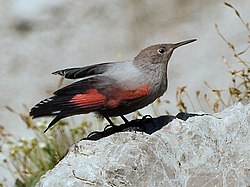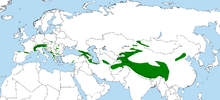Wallcreeper
| Wallcreeper | |
|---|---|
 |
|
| Scientific classification | |
| Kingdom: | Animalia |
| Phylum: | Chordata |
| Class: | Aves |
| Order: | Passeriformes |
| Suborder: | Passeri |
| Infraorder: | Passerida |
| Family: | Tichodromadidae |
| Genus: |
Tichodroma Illiger, 1811 |
| Species: | T. muraria |
| Binomial name | |
|
Tichodroma muraria (Linnaeus, 1766) |
|
 |
|
The wallcreeper (Tichodroma muraria) is a small passerine bird found throughout the high mountains of Eurasia. It is the only member of the genus Tichodroma.
There is some disagreement among ornithologists as to where the wallcreeper belongs in the taxonomic order. Initially, Linnaeus put it in the family Certhiidae, with the treecreepers. The wallcreeper is placed in a monotypic family Tichodromadidae by, amongst others, Clements 2007, while other authorities such as Dickinson 2003 put it in the monotypic Tichodromadinae, a subfamily of the nuthatch family Sittidae. In either case, it is very closely related to the nuthatches.
The genus name Tichodroma comes from the Ancient Greek teikhos "wall", and dromos "runner". The specific muraria is Medieval Latin for "of walls", from Latin murus, "wall".
There are two subspecies of wallcreeper:
The wallcreeper is a 15.5–17 centimetres (6.1–6.7 in) long bird, with a mass of 17–19 grams (0.60–0.67 oz). Its plumage is primarily blue-grey, with darker flight and tail feathers. Its most striking plumage feature, though, are its extraordinary crimson wings. Largely hidden when the wings are folded, this bright colouring covers most of the covert feathers, and the basal half of the primaries and secondaries.
A bird of the high mountains, the wallcreeper breeds at elevations ranging between 1,000–3,000 metres (3,300–9,800 ft). It is largely resident across its range, but is known to move to lower elevations in winter, when it is occasionally found on buildings and in quarries. Birds have wintered as far afield as England and the Netherlands, where one spent two consecutive winters between 1989 and 1991 at the Vrije Universiteit in Amsterdam. The species is resident across much of the Himalayas, ranging across India, Nepal, Bhutan and parts of Tibet.
...
Wikipedia

